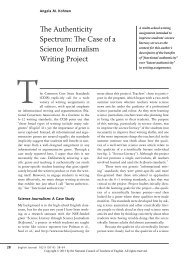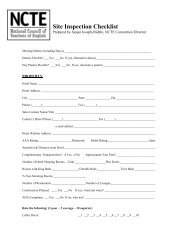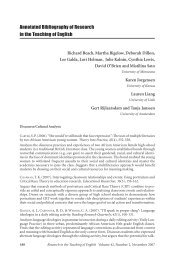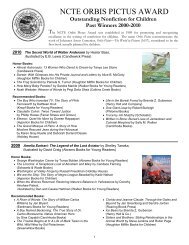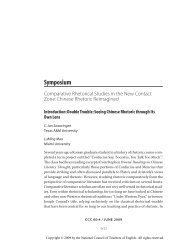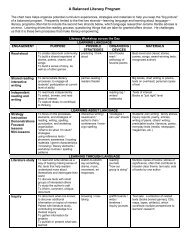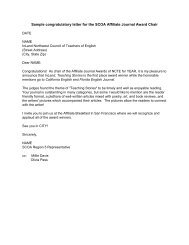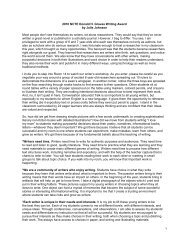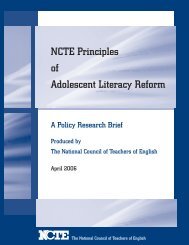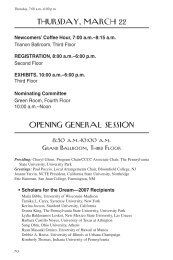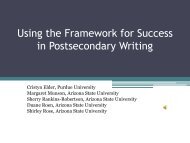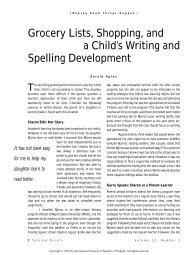Barbara Juster Esbensen
Barbara Juster Esbensen
Barbara Juster Esbensen
Create successful ePaper yourself
Turn your PDF publications into a flip-book with our unique Google optimized e-Paper software.
PROFILE<br />
BARBARA ESBENSEN<br />
M. JEAN GREENLAW<br />
At the annual convention in November 1994, <strong>Barbara</strong><br />
<strong>Juster</strong> <strong>Esbensen</strong> becomes the 10th recipient of the<br />
NCTE Award for Excellence in Poetry for Children.<br />
This award was established in 1977 and is presented to<br />
a poet for his or her aggregate body of work. It was the<br />
first award in the United States to honor children's<br />
poetry.<br />
<strong>Barbara</strong> <strong>Esbensen</strong> was born in Madison, Wisconsin,<br />
in 1925, and she spent the first 20 years of her life<br />
there. She graduated from the University of Wisconsin<br />
with a major in art education. For many years she<br />
taught art in grades K-12, but a move to Eureka,<br />
California, resulted in her becoming a classroom<br />
teacher. She has also taught art and creative writing to<br />
children and college education students.<br />
<strong>Esbensen</strong>'s first book of poetry, Suing around the<br />
Sun, was published in 1965. There was then a hiatus as<br />
she raised six children. She is married to Thorwald<br />
<strong>Esbensen</strong>, a writer and former educator. Their family<br />
has included six children, innumerable cats, and an<br />
ever-growing collection of grandchildren. This<br />
interview was conducted early in January, 1994.<br />
MJG: What were your reactions to learning that you<br />
were to be the recipient of the NCTE Award for<br />
Excellence in Poetry for Children?<br />
BE: I was astounded because it is very nice to know that<br />
people are actually reading your poetry and thinking<br />
about it. My experience has been that poetry is a little<br />
bit of a stepchild in the world of literature, and it is nice<br />
to know that somebody is reading it and considering it<br />
valuable. I think the award validates all the time that I<br />
have spent adoring words and putting them together and<br />
having a marvelous time looking at what is going on the<br />
page. You don't really hear a lot about yourself as a<br />
poet; you don't get many reviews or much feedback<br />
from teachers when you go to the schools, either. It<br />
seems to me that it is a rare teacher who already is<br />
enthusiastic about poetry. After I come to a school and<br />
tell them what kinds of things I am trying to do with the<br />
words, teachers then really become excited about what<br />
words can do. Many times teachers are focusing on only<br />
stories and informational books, so this is wonderful: It<br />
makes me feel like a star!<br />
MJG: Could you talk about your early years as a<br />
poet? Is there a writer who influenced you? What<br />
made you keep on going even though poetry is a<br />
stepchild?<br />
BE: In my family I was known as <strong>Barbara</strong>, "our little<br />
artist," and I did major in art at the University of<br />
Wisconsin. I was an art teacher for a long time, and I<br />
had a friend one time who said to me that when she<br />
hears me talk about painting, I'm talking about painting<br />
as if I'm a writer. So I know that words have always<br />
been something very, very vital to me, and I know I've<br />
always compared one thing with another in my head.<br />
When I was 13 years old, in the fall of1939, I was<br />
Language Arts, Vol. 71, November 1994<br />
544
P R O F I L E<br />
in 10th grade, and I wrote a poem because Russia<br />
invaded Finland. I heard about it on the morning news,<br />
on the radio before I went to school. I was fuming. I<br />
went to school, took a look at a map, and saw how big<br />
Russia was and how little Finland was.<br />
My philosophy is to present<br />
(students) with wild enthusiasm<br />
and kind of knock their blocks<br />
off. Crack their heads together<br />
and say, "Get it, get it!"<br />
That was the extent of my political and geographical<br />
knowledge, but I was so mad at Russia for invading<br />
Finland that I wrote a poem. I composed it in my head<br />
on the city bus, going home on a rainy November day.<br />
By the time I got to my home on Sherman Avenue in<br />
Madison, Wisconsin, I had composed this poem in my<br />
head, and I remember standing in our front hall,<br />
dripping and grabbing paper out of my notebook and<br />
writing it down. The next day I put it on the desk of my<br />
teacher, Eulalie Beffel. She called me up to her desk<br />
and said, "<strong>Barbara</strong>, do you write—have you written<br />
other poems?" I said yes. She said, "This is excellent.<br />
<strong>Barbara</strong>, you are a writer!" That did it: I believed her.<br />
She introduced us to Amy Lowell, Sara Teasdale, and<br />
Stephen Vincent Benet—the poets who weren't<br />
rhyming. I think all my previous experiences with<br />
poetry were exposures to "Flower in the Cranny Wall"<br />
and "The Highwayman." "Flower in the Cranny<br />
Wall"—I hate to tell you I know that poem because it is<br />
so dumb. I never really cared about that flower in the<br />
cranny wall. But when Miss Beffel gave me some<br />
poems by Amy Lowell and Emily Dickinson to read, I<br />
felt as though I were going to faint. It was so exciting to<br />
know that I was allowed to think these thoughts that<br />
were kind of bizarre and to know I didn't have to rhyme.<br />
MJG: Are you still in contact with Eulalie Beffel?<br />
BE: Oh, yes. In our family we call her Bess. She was<br />
my mentor then, and though she is 85, she has seen<br />
every sentence, every phrase, every paragraph, every<br />
poem I have ever written. I write her and say to her,<br />
"Bess, just write in the margin with red ink if it needs<br />
work." That is what she used to say at school.<br />
"<strong>Barbara</strong>!" she'd say. "This needs work!" But she<br />
changed my life. I've dedicated my new book that<br />
will be out in the fall to her. In the dedication it will say,<br />
"To Eulalie Beffel, my only teacher. You changed my<br />
life." She truly changed my life. I've always been a<br />
teacher. Sometimes you feel you aren't making a<br />
difference, but you still know you really are. I know I<br />
have made a difference to kids. It is astounding to know<br />
that kids are sitting in your classroom and that you are<br />
not making a difference. My philosophy is to present<br />
them with wild enthusiasm and kind of knock their<br />
blocks off. Crack their heads together and say, "Get it,<br />
get it!"<br />
MJG: Poets whose work wasn't rhymed had quite an<br />
impact on you; yet your first book of poetry, Swing<br />
around the Sun, published in 1965, is a book of<br />
rhymed poetry.<br />
BE: Yes, actually I was always writing other poetry that<br />
didn't rhyme and sending it out to Saturday Review and<br />
other magazines like that because I didn't know what<br />
else to do with it. In the early 1960s, a publisher who<br />
didn't publish children's books told me that he didn't<br />
think I would get anywhere with poems that didn't<br />
rhyme and suggested I write a book of poetry that<br />
rhymed. So I wrote Swing around the Sun, and, you<br />
know, the poems in there are good. I never take that<br />
book with me when I'm talking to children, however,<br />
because I don't want them to horse around with rhyme;<br />
it is too confining, and they get too tinky tanky. But the<br />
images that I've used in Swing around the Sun are good,<br />
so the rhyme doesn't take away from them. I have a<br />
book coming out called Dance with Me, in which I have<br />
written about every single thing I could possibly think<br />
of that dances: dust motes, a mother who is doing a little<br />
dance with her hoe in her garden, and that stuff that's on<br />
the highway that causes a mirage of water when we<br />
drive in the summer. The poems rhyme, and I'm a little<br />
nervous about that book coming out and taking it out to<br />
show children. But I've hidden the rhymes in the middle<br />
of lines so it doesn't seem like everything is an end<br />
rhyme.<br />
MJG: But rhyme can be enjoyable.<br />
BE: Yes, it's all right. Except that kids keep rushing<br />
toward the end of the line, and they are going June,<br />
moon, spoon, baboon, spittoon. There is a section in<br />
my introduction to A Celebration of Bees: Helping<br />
Children Write Poetry, where I give examples of work<br />
that was written in my third-grade class in Eureka,<br />
California. My students did a lot of poetry writing. I<br />
had a girl named Elvira Marin who just wrote<br />
545
L A N G U A G E A R T S<br />
wonderful stuff, and then later when she was in fifth and<br />
sixth grade she wrote things like "007 has gone to<br />
heaven" just terrible stuff. She wrote me a letter and<br />
said, "I know this isn't any good, but our teacher says all<br />
poems have to rhyme," and she also included a little<br />
squib that she had been thinking about that was just<br />
marvelous. So, writing poetry that rhymes is a real<br />
danger because I'm worried the teachers will pick up on<br />
it and say, "Now boys and girls, you heard Mrs.<br />
<strong>Esbensen</strong>'s poems, so let's all sit down and write<br />
poems." And they are all going to be rotten!<br />
MJG: Your next book of poetry after Swing around the<br />
Sun is titled Cold Stars and Fireflies, and it was<br />
published in 1984. That is almost a 20-year time difference.<br />
Why the long time between books of poetry?<br />
BE: In the midst of all that I had five children, and I<br />
wrote A Celebration of Bees, which took me several<br />
years. Although I wrote it in 1971, it wasn't published<br />
until 1975. It often takes several years from the time I<br />
write my book to the time it is published. Some of that<br />
period is the time it takes for my illustrator to complete<br />
the art.<br />
MJG: I find it fascinating that you also write awardwinning<br />
informational books. To most people poetry and<br />
nonfiction seem to be very opposite in style. When you sit<br />
down to write an informational book, what do you do that<br />
is different from writing your poetry?<br />
BE: For one thing, I want to be sure that everything is<br />
absolutely accurate. Still, I'm writing about things I'm<br />
really in love with, such as loons, owls, and otters. I have<br />
just written a new book about sponges that is out from<br />
HarperCollins—I wasn't really in love with sponges to<br />
start with, but they are very interesting. I also want to do a<br />
book on wolves. So in addition to all the information that I<br />
want to be absolutely accurate, I'm trying to get my<br />
impressions—my almost physical impressions—of these<br />
animals I adore onto the page. Therefore I'm trying to<br />
choose words the way I would in poetry to get these<br />
impressions across. I think strong verbs and images are<br />
what make the animal come alive, and that is what I'm<br />
trying to do. Its got to be more than Sergeant Friday on<br />
"Dragnet"—"just the facts, ma'am." We want more than<br />
the facts. We have to make animals come alive. When I'm<br />
talking about how the owl sails and glides, I choose words<br />
that give us the feeling of that quiet, silent glide.<br />
MJG: What kept coming up over and over again when<br />
the Committee discussed your work was the images you<br />
present. What moved us is the clarity of your images, the<br />
differentness of your images. We just kept coming back<br />
to reading your poems aloud. Do you think that your<br />
beginning as an artist has to do with your focus? You<br />
know some poets focus on rhyme, some on word play,<br />
and some on puns. But you seem to focus on image.<br />
BE: I'm sure that I'm looking all the time. I'm sure of<br />
that because I am an artist, and that's what I have really<br />
been doing all my life. I'm a looker! And I'm an<br />
exaggerator.<br />
As I tell kids, you can't just<br />
think. I t doesn't do any good<br />
just to think. You must see it on<br />
the paper . . .<br />
My former husband and I went for a walk one day when<br />
we noticed the robins had come in from Canada. There<br />
were robins all over someone's lawn, and I said, "Oh my<br />
gosh, there are a million robins on that lawn." He said,<br />
"A million robins? There are probably 22." I said,<br />
"David, there is no way on this earth that I care that there<br />
are 22 robins on that lawn. You count the robins, and I'm<br />
telling you that the impression is of robins neck-to-neck,<br />
wall-to-wall." I tell children you are allowed to say<br />
things that are absolutely off-the-wall in poetry.<br />
MJG: What is your writing process like when you<br />
are working with poetry?<br />
BE: When I'm working with poetry, I sit and stare. I<br />
work with the computer, which certainly does free you<br />
up, I must say. I give myself a subject. In the book<br />
Dance with Me, I wrote a list of all the things I could<br />
think of that danced. That list helped me get going. I'll<br />
give you an example of something else. I've written a<br />
book on the Aurora Borealis. What I did there was write<br />
down every single word I could possibly think of that, to<br />
me, described the Northern Lights. I filled two pages<br />
with all kinds of verbs, colors, and images like sifting<br />
and powdered—unusual combinations. As I tell kids,<br />
you can't just think. It doesn't do any good just to think.<br />
You must see it, on the paper, which is why I wrote<br />
"Pencil." I tell students the poem is in the pencil. The<br />
words are all in there, and as soon as you start letting a<br />
546
P R O F I L E<br />
few of them out on the paper, you're surprised; they are<br />
all holding hands, and they are all yanking each other<br />
along. In other words, they are going to come out on<br />
that page. You are going to be astounded when you stop<br />
writing and you put your pencil down. What's on the<br />
paper is astonishing.<br />
MJG: It is interesting that every time we talk about a<br />
topic, you immediately go back to children and<br />
teaching.<br />
BE: True. This is the way I want to talk to students<br />
about my own work. I tell them that poetry is something<br />
we all can do if we are permitted to do it.<br />
MJG: Each of your books works around a theme. Do you<br />
start with a theme first and then write your poetry for the<br />
theme, or do you write poems and suddenly see that they<br />
fit a theme?<br />
BE: I deliberately wrote about the seasons because I<br />
love them. Both Swing around the Sun and Cold Stars<br />
and Fireflies are about the seasons. Now, in writing<br />
Words with Wrinkled Knees, I had the feeling that some<br />
words are so perfect for what they are that it is almost<br />
as if they had invented themselves. I thought that I was<br />
just going to write a book about words—maybe animal<br />
words, maybe musical instrument words, maybe some<br />
weather words—who knows? When I called <strong>Barbara</strong><br />
Fenton and told her my idea, I had three poems written.<br />
I had a poem about an elephant and one about a<br />
hippopotamus. Then I had a poem about a xylophone<br />
because I could picture this long word "xylophone,"<br />
with an arm at each end tapping out its own name. I<br />
read those poems to <strong>Barbara</strong>, and she started to laugh.<br />
She said, "I'm going to take this book, but forget about<br />
the music words. Just concentrate on the animals." So<br />
that's how that book happened.<br />
MJG: You have several books coming out that are<br />
waiting to be illustrated. What are the themes of<br />
those?<br />
BE: I am delighted about a book that Helen Davie, who<br />
illustrated The Star Maiden and Ladder to the Sky, and I<br />
are collaborating on. Our editor called me one day and<br />
asked what I would love to write if Helen could<br />
illustrate it. I told her I love to think about patterns in<br />
nature. I'm just astounded at how there are patterns<br />
everywhere you look, and I don't think children know<br />
about this. She started to laugh, and she said, "Helen<br />
told me the same thing." Helen then sent me a folder<br />
full of information that she had been gathering for years<br />
on patterns in nature, and I had been doing the same<br />
thing myself. Isn't that amazing? So I wrote a book<br />
called Echoes for the Eye.<br />
MJG: You also have written some folklore. How do<br />
you seek out the sources for your folklore? What<br />
moves you to say, "This is a story I want to tell?"<br />
BE: For The Star Maiden, I read the story in the<br />
collection called Book House. The tale I retold was<br />
called "Legend of the Water Lily." When I decided to<br />
retell "Legend of the Water Lily," I sent it to Little,<br />
Brown. I called them up and said I had a story I would<br />
like for them to look at. They said fine, send it. In two<br />
minutes they called me back and said they loved it. It<br />
seems little children apparently also loved The Star<br />
Maiden because it has been one of their best-selling<br />
books for a number of years. Little, Brown wanted to<br />
know the source for the story; Book House said it was<br />
an Ojibwa tale and gave no source beyond that. So I<br />
turned to my other great love, librarians. I called the<br />
public library, and Lois Renquist found the original<br />
story for me in a book published in 1860 by an Ojibwa<br />
chief. I wrote that source on the copyright page. In that<br />
source there was also the story that I call Ladder to the<br />
Sky; it was a description by the chief of some things<br />
that he had learned while he was preparing to become a<br />
medicine man in his Ojibwa nation. So that was a<br />
wonderful extra plus for me because I thought that was<br />
a very exciting story.<br />
MJG: I would just like to end by asking what advice you<br />
have for teachers who are afraid to use poetry in<br />
school, to free them up to be willing to take a chance<br />
with poetry.<br />
BE: Teachers should get into some kind of poetry<br />
workshop, which could be very scary for them if they<br />
don't feel they are writers. They need to join a friendly<br />
poetry workshop and see what it is like to write poetry<br />
before they try to get kids to do it. They really need to<br />
do it themselves. I also think that teachers who are<br />
going to read a poem to children should take a long<br />
hard look at the poem itself and, in a very flat little<br />
summary, write down what the poem is about. Then,<br />
they can point out what the writer does that makes this<br />
"about" come alive. Too many school children are<br />
worried about being right, about not being wrong, and<br />
about not saying something stupid. They don't want to<br />
be laughed at. If you have an accepting, adventurous<br />
atmosphere in a classroom, you may find some poets.<br />
547
LANGUAGE ARTS<br />
Bibliography of <strong>Barbara</strong> <strong>Esbensen</strong>'s Works<br />
Poetry<br />
<strong>Esbensen</strong>, B. J. (1965). Swing around the sun. New York: Lerner.<br />
<strong>Esbensen</strong>, B. J. (1984). Cold stars and fireflies. Illustrated by Susan Bonners. New York: Crowell/HarperCollins.<br />
<strong>Esbensen</strong>, B. J. (1986). Words with wrinkled knees. Illustrated by John Stadler. New York: HarperCollins.<br />
<strong>Esbensen</strong>, B. J. (1992). Who shrank my Grandmother's house? Illustrated by Eric Beddows. New York: Harper-<br />
Collins.<br />
Other Books<br />
<strong>Esbensen</strong>, B. J. (1975). A celebration of bees. Minneapolis, MN: Winston Press.<br />
<strong>Esbensen</strong>. B. J. (1988). The star maiden. Illustrated by Helen K. Davie. Boston: Little, Brown.<br />
<strong>Esbensen</strong>. B. J. (1989). Ladder to the sky. Illustrated by Helen K. Davie. Boston: Little, Brown.<br />
<strong>Esbensen</strong>, B. J. (1990). Great northern diver Illustrated by Mary Barrett Brown. Boston: Little, Brown.<br />
<strong>Esbensen</strong>. B. J. (1991). Tiger with wings. Illustrated by Mary Barrett Brown. Boston: Little, Brown.<br />
<strong>Esbensen</strong>, B. J. (1993). Playful slider. Illustrated by Mary Barrett Brown. Boston: Little, Brown.<br />
<strong>Esbensen</strong>, B. J. (1993). Sponges are skeletons. Illustrated by Holly Keller. New York: HarperCollins.<br />
<strong>Esbensen</strong>, B. J. (1994). Baby whales drink milk. Illustrated by Lambert Davis. New York: HarperCollins.<br />
<strong>Esbensen</strong>, B. J. (1994). The dream mouse. Illustrated by Judith Mitchell. Boston: Little, Brown.<br />
<strong>Esbensen</strong>, B. J. (1994). The great buffalo race. Illustrated by Helen K. Davie. Boston: Little, Brown.<br />
M. Jean Greenlaw is Regents Professor of Education at the University of North Texas and Chair of the NCTE<br />
Award for Excellence in Poetry . for Children Committee.<br />
548



